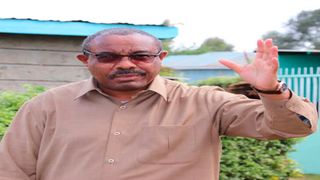
Former Ethiopian Prime Minister, Hailemariam Desalegn in Kiambu County.
| Isaiah EsipisuSeeds of Gold
Premium
Yes, Africa’s journey to be food secure is on course, but slow
What you need to know:
- As African countries integrate their trade to create a single large market, agriculture sector would be one of the biggest beneficiaries.
- In my trip to Kiambu, I was happy to see an innovative private sector lead approach called the village based advisor (VBA) or agent model.
How far are we from an inclusive agricultural transformation (IAT) in Africa and what are the major challenges?
We are seeing good progress in various countries in terms of leadership from the top, resources committed and focused approach in building input systems, extension services, markets and affordable financing using a public private partnership approach.
IAT should be seen at various levels. For farmers, it means the exit from subsistence farming to commercial agriculture in which incomes and productive assets grow. Agriculture is big business in Sub-Saharan Africa, projected to be a $1 trillion (Sh108 trillion) industry by 2030 compared to $313 billion (Sh34 trillion) in 2010, which is why it should be at the top of the agenda for economic transformation and development.
What should our leaders do to make the continent food and nutrition secure?
First, we need to credit our leaders for recognising the critical role that agriculture can and must play in transforming their economies. Starting with 2003 declaration and commitments in Maputo, to 2014 in Malabo, Africa’s leaders have consistently sent strong messages and signals for agriculture and food security. But the numbers and results we are seeing are not optimal.
The continent is not on track to achieve the UN Sustainable Development Goals 1, 2, 3 by 2030. More than 280 million Africans are still going to bed hungry, and these numbers are increasing because of cycles of droughts and floods and related pest damage all resulting from climate change. And now, Covid-19 has thrown very many people out of jobs and increasing numbers of the food insecure.
Another sobering fact is that the United Economic Commission for Africa recently projected $43 billion as Africa’s annual food imports. This urgently calls for a radical transformation to wean the continent from this dependence that is projected to soar to $110 billion by 2025. The ongoing food systems summit dialogues are critical for Africa to define its future food systems.
The message is simple. Leaders must take bold actions to reverse these trends. They need to set, reiterate and clearly communicate their national visions, strategies and plans and commit to more ambitious goals. Kenya’s President Uhuru Kenyatta has set a good example by committing to the Big Four Agenda and creation of the Agriculture Growth and Transformation Strategy. Rwanda is making strong progress, its leaders have made a choice to set strong and ambitious targets and ensure that accountability is not compromised.
What lessons have we learnt from the Covid-19 pandemic in relation to food security in Africa?
As Covid-19 took a hold in African communities, many governments implemented critical measures to protect their people – tightening or closing land borders, restricting air traffic, reducing access to public services, banning civil gatherings and closing schools. Despite including agriculture as an essential service, which is commendable, the measures impacted the supply chain of the sector exposing some vulnerabilities across the value chain.
This disrupted inputs and markets access which destabilised food availability and prices across the continent. Lessons picked from these include governments need to ensure that national response plans enable farmers and agriculture SMEs access input and output markets, private sector actors should complement and coordinate with national response plans to ensure continued access to agricultural technologies and accelerate digital agriculture solutions such as extension and finance, and access to markets and development partners should mobilise collective voice, knowledge, resources, and action to efforts directed at mitigating the impact of Covid-19.
During your recent visit to rural Kenya, what agricultural lessons did you pick that other African countries should emulate?
Kenya is a champion in many fronts, and it’s always a privilege to come and learn new things here. In most countries, the extension ratio to farmers is more than 1:3,000. In my country Ethiopia, we took a public sector approach and hired more than 100,000 extension officers and did manage to reduce the ratio significantly, however, this came at heavy recurrent cost to government.
In my trip to Kiambu, I was happy to see an innovative private sector lead approach called the village based advisor (VBA) or agent model. This is a cost-effective and sustainable model as it leans on a partnership between government and private sector and builds on the trust between farmers.
I saw the various seed varieties under demonstration plots, adoption of agroforestry and other regenerative agriculture practices. I also saw women positively engaged as owners of land assets, what is critical as it drives equity and inclusion of women in acquisition of productive assets and profitable agriculture.
How will the Africa Continental Free Trade Area (AfCFTA) unlock the continent's agricultural potential?
There are three main pathways, although not exclusive, that the AfCFTA will impact agricultural transformation. First, through enhanced productivity in reduced cost of agriculture inputs, expanded market for agriculture outputs, and attraction of FDIs along key agriculture value chains.
Generally, the agreement is expected to lift 30 million Africans out of extreme poverty and boost the incomes of nearly 68 million others who live on less than Sh150 a day. Most of these poor are farmers, traders and largely women.





